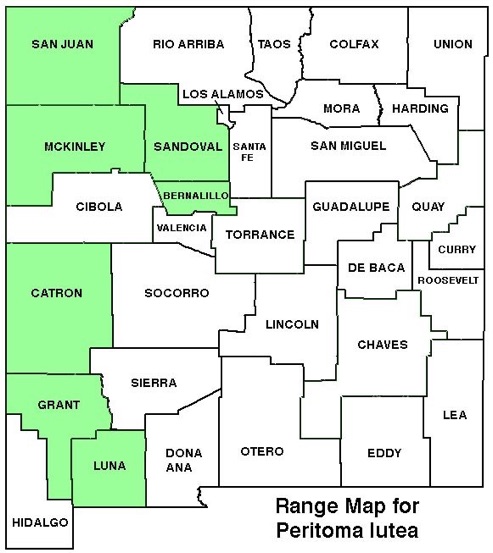WILDFLOWERS OF NEW MEXICO

Colonies of this bushy-stemmed annual can cover sandy roadsides and disturbed fields and plains. The 1–5 foot tall stems are topped with showy clusters of yellow flowers with long protruding, spidery stamens. Note the slender seed pods hang down below the flower clusters, and the palmate leaves have 3–7 linear to elliptic leaflets spread like fingers on a hand.
FLOWER: April–September. Spike-like clusters with elongated to rounded heads are packed with numerous flowers with 4 yellow petals; the yellow stamens extended beyond the petals, like a pin cushion. The stems elongate with the ripening slender seed pods dangling from the stem underneath the flowers.
LEAVES: Alternate; petioles (leaf stalks) 1–2 inches long. Blade palmately divided into 3–7 linear to elliptic segments, each to 3/4–2 inches long (2–5 cm), up to 3/8 inch wide (1 cm).
HABITAT: Dry sandy, gravelly soils; washes, flats, disturbed soils, roadsides; desert scrub, pinyon-juniper-oak woodlands, ponderosa forests.
ELEVATION: 4,000–8,000 feet.
RANGE: All states west of Rocky Mts.
SIMILAR SPECIES: Rocky Mountain Beeplant, P. serrulata, with a similar range, has pink flowers. The widespread Clammyweed, Polanisia dodecandra, has white flowers, sticky, foul-smelling leaves, and fruit capsules that grow upward.
NM COUNTIES: Western NM in mid-elevation, dry habitats: Bernalillo, Catron, Grant, Luna, McKinley, San Juan, Sandoval.









YELLOW BEEPLANT
PERITOMA LUTEA (CLEOME LUTEA)
Beeplant Family, Cleomaceae (formerly Cappariadceae, Caper Family)
Annual herb


















THE CONTENTS OF THIS WEBSITE ARE COPYRIGHTED AND CANNOT BE USED
WITHOUT PERMISSION OF GEORGE OXFORD MILLER
















EMAIL ME





























































